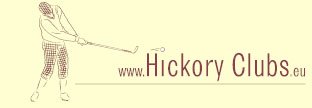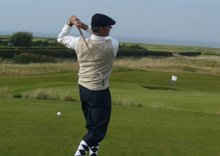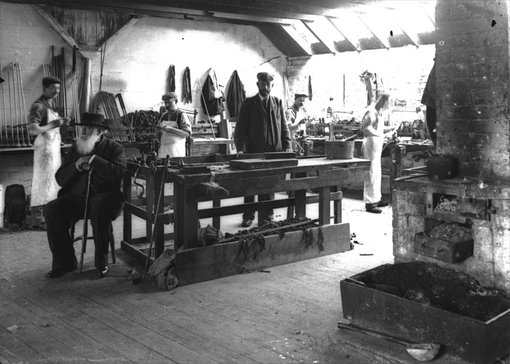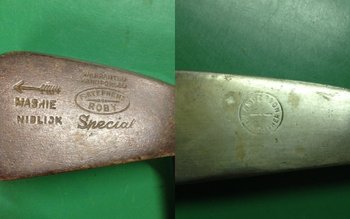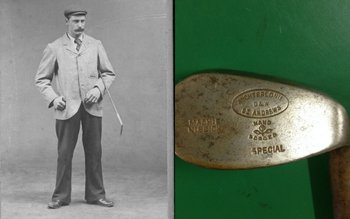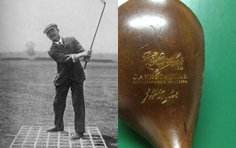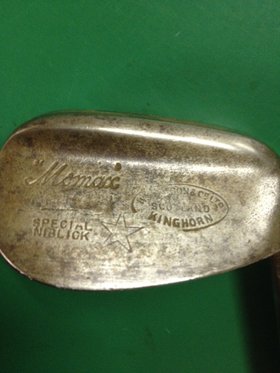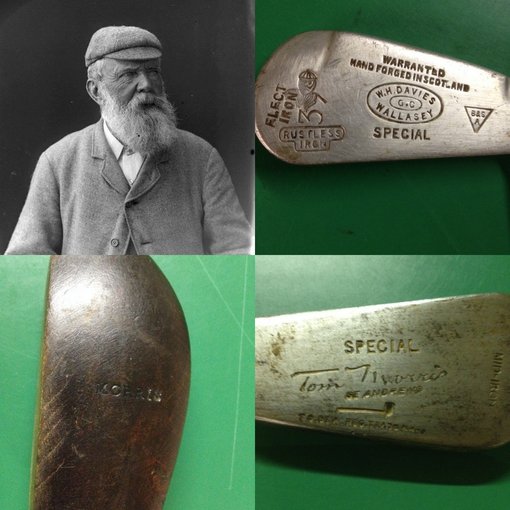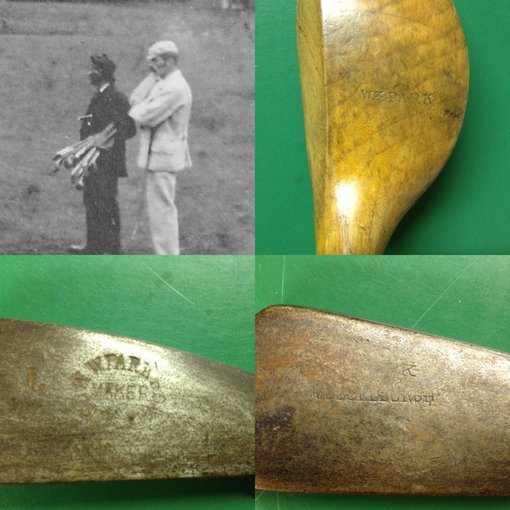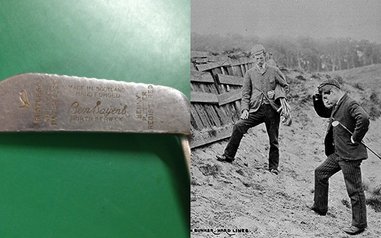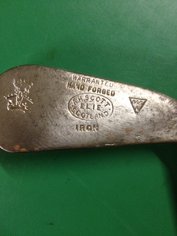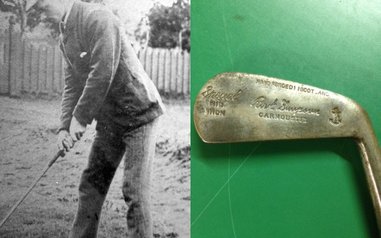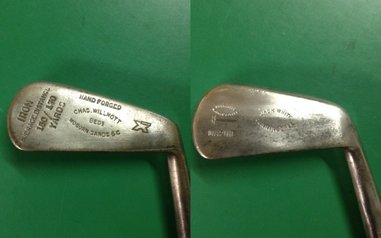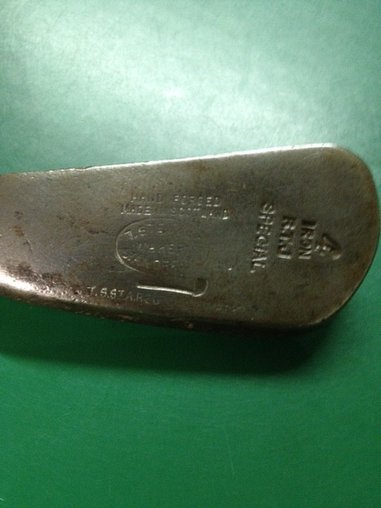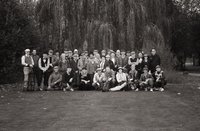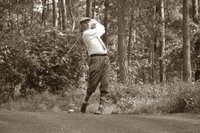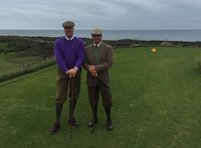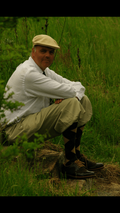Hickory Clubs.eu
Golf as it was meant to be
Clubmakers
The following are amongst the most well known clubmakers from the hickory shaft period.
Anderson & sons, D (St. Andrews) this famous St. Andrews maker started his business in 1893 that previously existed as DW Anderson. The factory lay next to the 18de green of the Old Course. David Anderson was the son of the legendary Old Da, a ballmaker and greenkeeper of the Old Course. All of David’s 5 sons worked for the firma until it ceased trading in 1939.
Anderson, James (Ansturther) James Anderson was a blacksmith from trade. In 1860 he started to make occasional clubs. They were so popular that by 1880 he had stopped making anything else. Anderson became one of the most important clubmakers in history and a lot of famous clubmakers served their apprenticeship by him. (Incl: George Forrester en Robert Condie). When he died in 1895 his son James Jr took over the company. The business remained successful until the start of the 2nd world war.
Auchterlonie D&W (St Andrews) Brothers David and Willie started their successful clubmaking business in 1896. De family Auchterlonie was already famous because of their playing ability. Willie won the Open in 1893 and his cousin Laurence won the US Open in 1902. The firm continued making clubs until 1955. Their shop in St.Andrews still exists today.
Cann & Taylor (Sheen, Surrey) JH Taylor the legendary 5 time Open Champion had a very successful clubmaking business together with his fellow professional George Cann. They started production in 1894 and expanded quickly. Their famous mashie (made popular when Taylor used it to win the Open) was a very good seller. Like many other firms they stopped production just before they war (1939).
Condie, Robert (St Andrews) after apprenticeships with James Anderson and Robert White, Condie set up on his own in 1890. His famous fern or rose cleek marks can be found on some of the most beautiful clubs ever made. Condie believed in old fashioned production methods and was one of the last makers to hand forge his clubs His son George continued the firm after his death in 1923.
Forgan, Robert (St. Andrews) Forgan took over the firm of his uncle (Hugh Philps) in 1856 after serving an apprenticeship there from 1852. Most of the still existing play (long nose) clubs were made by the Forgan firm. His sons continued with the company until it was sold to Spalding in 1960. Forgan & Son were from 1863 until 1908 the official clubmaker to the English royal family. They made a lot of advertisements publicising this fact.
Forrester, George, ( Elie and Earlsferry) Forrester is famous as one of the most respected and initiative clubmakers of his generation. Round 1870 he started with making classic play (long nose) clubs but during his career he invented both socket neck woods and concentric irons. When he died he had more patent applications than any other clubmaker.
Gibson, William (Kingshorn) Gibson started like many other makers as an apprentice to James Anderson, by 1896 he was his own boss. His Famous star cleekmark (see Photo) is one of the cleekmarks often found on clubs today, this not surprising when one considers that Gibson was for years the biggest producer of clubs in the world.
Gourlay James (Carnoustie) started life as a blacksmith in about 1893, and probably made a few clubs in this period. Gourlay was making beautiful cleeks in the beginning of the 20th century .His moon and star cleekmark was first used in 1904. Gourlay died in 1908 but his son kept the company successful until 1930.
McEwan & Sons D (Mussleburgh) was the oldest clubmaking firm in the world when it stopped in 1895. James McEwan started in 1770 and another 5 generations followed him. The earliest clubs had a thistle mark and are extremely rare and valuable. The 3rd generation McEwan, Douglas made especially beautiful clubs and they are sought after by collectors.
Morris Tom (old) (St. Andrews) is a legendary name in the history of golf. Four times Open Champion (the same as his son, young Tom) old Tom was the greenkeeper, caddymaster and professional of the Old Course and a very successful clubmaker. Morris started as a ball/clubmaker apprentice to Alan Robertson , he became the professional at Prestwick, in 1854 and only when, in 1864 after returning to St Andrews did his clubmaking business start to flourish. His shop was next to the 18de fairway in St Andrews and he stayed active until his death in 1908. Morris clubs are still made (under license) today.
Nicoll George (Leven) started his firm in 1881 and it is still in existence today under the ownership of the St Andrews golf company. Famous for his hand cleek mark and his top quality, Nicoll’s clubs were often exported to America. The company of Burke (Ohio) acted as agent in the US.
Park Willie (Musselburgh) son of Auld Willie, 2 times Open Champion and clubmaker, took over his fathers business in 1884. He produced many innovative products and was very successful. Willie had a great reputation as both player (he also won the Open twice) and as clubmaker. Around the turn of the century he was one of the biggest producers in the world. He remained active as clubmaker until 1910 after which he became interested in course architecture.
Patrick Alex (Leven) son of clubmaker John, advertised the fact that his company was the second oldest in existence ( 1847) .Patrick irons were often made by James Anderson, and Patrick himself made both long nose and bulger woods. Patrick clubs were produced until 1930.
Philps Hugh (St Andrews) Known as the Stradivarius of club making. Philips was Robert Forgan’s uncle; he made beautiful elegant play (long nose) clubs between 1819 and 1855. His clubs were so sought after by players and early collectors that shortly after his death other clubmakers started producing forgeries of his work.His clubs are today almost priceless, good examples sell for 10’s of thousands of dollars.
Sayers Ben, (North Berwick) . Little Ben was only 5 feet 2 inches tall but quickly became a big name in the golf world. He was a clubmaker from 1890; but only after1910 did his company become a large scale producer. Well known as a player and teacher his club making business flourished and is one of the few hickory company’s that still exists.
Scott AH (Elie) cousin of and apprentice to George Forrester, he became a well known name with his patented unbreakable neck woods in 1894. In 1902 he started (like Forgan) to use Royal warrant as a cleekmark, first the 3 feathers of the Prince of Wales and later (1908) the crown and lion.
Simpson Robert (Carnoustie) was an apprentice to both Forrester and Forgan he started on his own in 1883. He was renowned for his quality and for his innovative products. His clubs are today very collectable.
Spalding AG (London and Dysart) This American producer had factories at many locations; it was the first company that sponsored a professional athlete/golfer (Harry Vardon), in 1899. His promotional tour of America produced huge amount of publicity for Spalding. Spalding still makes clubs today and is owned by Callaway.
Standard Golf Co (Sunderland) Aluminium producer Mills started in 1890 to produce golf clubs with an aluminium head. Within a few years these club became enormously popular. Their huge putter range putter made their name, but it was their introduction of metal woods that is most significant. The Standard Golf Company continued producing clubs until the start of the Second World War.
Stewart Thomas (St. Andrews) Stewart is probably the most famous hickory cleekmaker in the world. He produced millions of club heads (he only made club heads and not complete clubs) between 1893 and1932; and his eye for perfection was legendary. Many of the worlds best players used Stewart irons (Old Tom Morris, Bobby Jones, Francies Quimet and many others).Jones could choose out of 200 different Stewart irons when he won the grand slam in 1930.The photo is of a RTJ model 4 iron, a series that where copies of Jones 1927 Stewart set. Stewarts clubs have usually his famous pipe cleekmark (see photo) stamped on the back of the club .His clubs are today, very popular with collectors.
Winton & co (Montrose and London) the Winton family start clubmaking at several locations round 1890, from 1910 they operated together as a family business. Winton’s sold the legendary putter Calamity Jane. This putter and a later copy was used, by Bobby Jones throughout his carrier. Winton clubs can be recognised by a diamond cleekmark (see photo).
S
